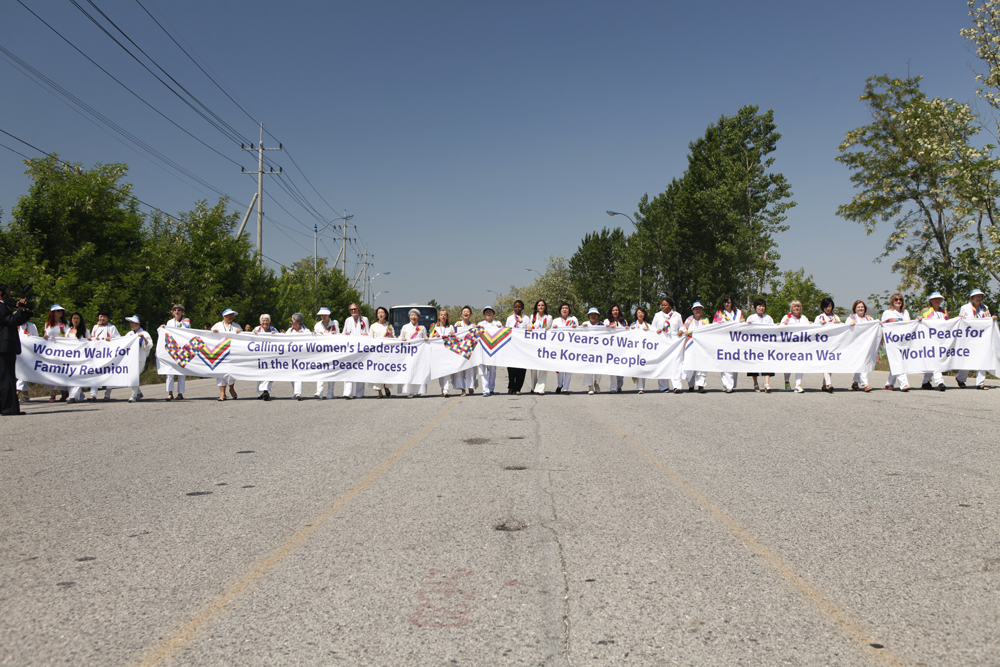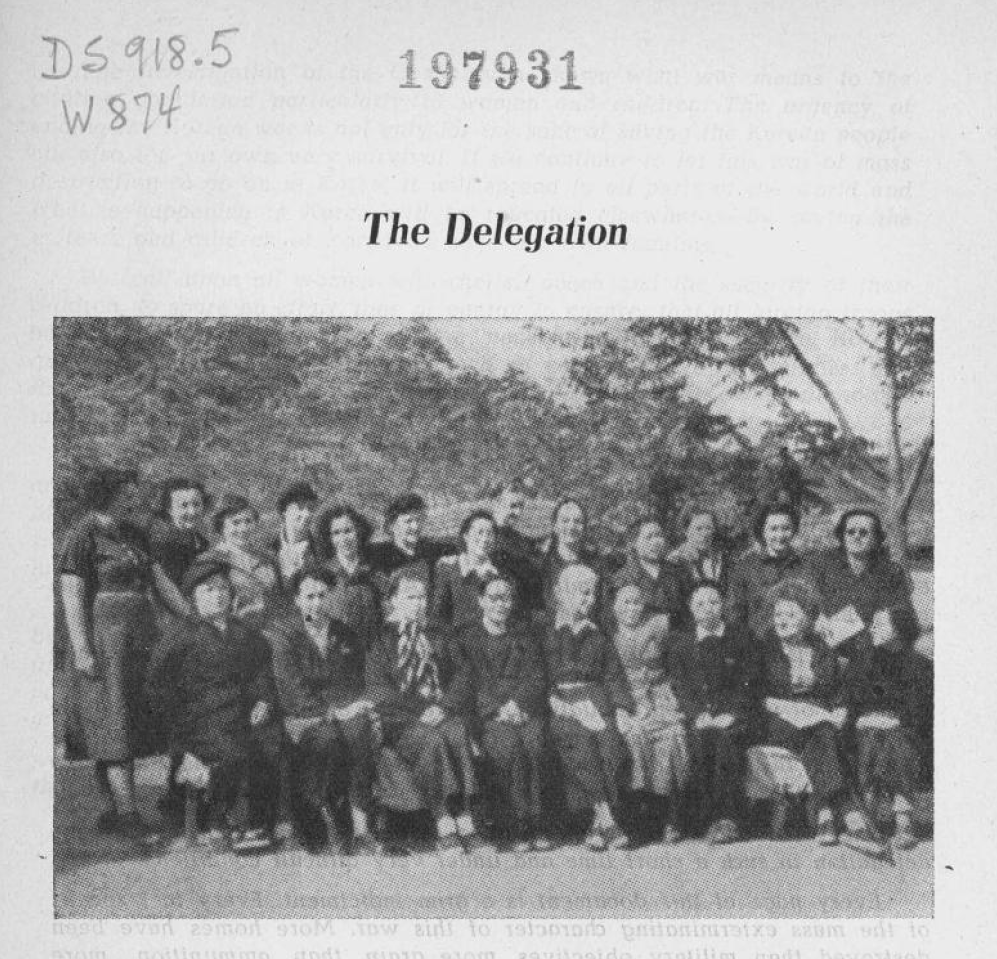The February 2018 Pyeongchang Winter Olympics in South Korea set the stage for the historic inter-Korea and North Korea-US summits, which occurred in quick succession in the following months. The North and South Korean leaders, Chairman Kim Jong Un and President Moon Jae-in, crossed the Demilitarized Zone (DMZ) as they met each other at Panmunjom in April. Then in Singapore in June, Donald Trump and Kim Jong Un shook hands, a first for a sitting US president and a North Korean leader. Most pundits have focused on the theatrics of these meetings, with their male leads, with little awareness of how the path to peace was paved, often behind the scenes, by women. Whether as diplomats, activists, or cheerleaders, women peacemakers have put into practice what a substantive “demilitarized” peace entails.
Cold War notions of militarized peace assume that it can only be secured through military preparedness, as exemplified by the DMZ itself. After it was established by the 1953 Armistice Agreement that temporarily stopped the Korean War, the DMZ became one of the most heavily militarized borders in the world–and yet many paradoxically see it as maintaining peace in Korea. A truly demilitarized peace is a method and an active struggle, rather than the mere absence of violence, and it must be forged through face-to-face personal interactions and relationships. In that sense it is inherently a feminist praxis that embraces interdependence as strength, not “weakness.”
However, when women are recognized at all, they are too often dismissed as naïve “dupes” or complicit “stooges.” For instance, Kim Jong Un’s sister Kim Yo-jong was at best dismissed as merely her brother’s messenger, or, worse, depicted by American media as harboring sinister motives. By contrast, the South Korean public noticed her diligence and her dignified hair and dress with minimal makeup. It is instructive to compare the photos used in South Korean coverage of Kim with the photos used in the US. The Korea Times, for example, characterized Kim as “cheerful…and at other times humble…rarely haughty or arrogant.” Such characterizations were quickly decried in the US, with journalists suggesting that South Koreans were falling for North Korean propaganda that attempted to put a human face to a brutal regime.
This double vision has a long history that goes back to the Cold War. In the case of Korea, it manifested in the treatment of the international delegation of women who came together to investigate war crimes during the Korean War at the request of the Korean Democratic Women’s Union. The umbrella North Korean women’s organization founded in 1946 and still in existence today was led by women leaders such as Ho Chong-suk and Pak Chong-ae, two well-known socialist feminists who began their political careers during the Japanese occupation period (1910-1945). Despite their anti-colonial activism, neither has received much recognition in South Korean feminist scholarship due to their high ranks in North Korea. Likewise, due to Cold War historiography, the Women’s International Democratic Federation, one of the largest international women’s organizations to be founded in the aftermath of World War II, which commissioned the women’s fact-finding delegation to Korea in 1951, has been erased from the history of the international women’s movement.
Despite the transnational character of the delegation of twenty-one women from the Americas, Europe, Asia, and Africa who visited North Korea from May 16th to 27th in 1951 [see cover image at top], at great risk to their own safety, their subsequent report titled We Accuse!, indicting the United States of war crimes, was dismissed as propaganda because they were unable to visit the South. Despite the women’s diversity of background and expertise, they were red-baited as part of the Soviet “peace offensive” and dismissed as “dupes” and “stooges.” Similar reactions were faced by the 2015 International Women’s Peace Walk [Figure 1] calling for the peaceful reunification of Korea on the seventieth anniversary of its division. On May 24, 2015—International Women’s Day for Peace and Disarmament—thirty women peacemakers from fifteen nations, including two Nobel Peace Prize laureates, walked with thousands of Korean women of the North and South to call for an end to the Korean War and the peaceful reunification of Korea. Meeting face-to-face and standing side-by-side in solidarity, feminist peacemakers linked war-torn Korea as well as its disjointed remnants along the DMZ to the rest of the world through their own physical presence to show how the world was indeed interdependent.

Figure 1: May 24, 2015 International Women’s Peace Walk. Photograph by Niana Liu
A follow up to the 2015 Peace Walk took place in Bali, Indonesia in February 2016, where an international group of women were able to meet with women from North and South Korea. The meeting produced an agreement in which women decided to work to prevent military action and advocate for peace in Korea, including “the eventual denuclearization of the Korean Peninsula and the entire world” through women’s leadership in the peace process. At a time when inter-Korean relations were at an all-time low following another North Korean nuclear test in January 2016 that led to the closing of the Kaesong Industrial Complex—the last remaining symbol of inter-Korean cooperation—the women’s gathering was significant as an example of people-to-people engagement led by women and driven by a commitment to peace.
While officially North Korea had declared itself a nuclear weapons state with the sovereign right to its own nuclear deterrence, the women’s meeting confirmed that its policy of denuclearization as outlined in the 1992 Joint Declaration of the Denuclearization of the Korean Peninsula had not changed, so long as the world showed the same commitment to denuclearize. Focused as it was on forging deeper working relationships through closed-door meetings, the Bali meeting and its subsequent agreement received far less, if any, public attention, but it embodied another example of feminist peace praxis.
And yet, women are repeatedly characterized as mere decoys and pawns. North Korean cheerleaders at the Winter Games were uniformly scorned as “armies of beauties” sent on a “charm offensive” to woo the international community in a propaganda campaign and further derided as having been chosen for their looks from among good families as a way for the regime to ensure loyalty. Despite that South Korean and North Korean cheerleaders wore similar red tracksuits and white hats, the South Korean opening ceremony dancers became “unsung heroes” for cheering in the frigid temperature, whereas North Korean women became “armies of beauties”–a term that seems to have germinated from within Western media but that was consistently presented as though it was a quotation from Korean sources.
These representations bordered on Orientalist Cold War depictions reminiscent of the “yellow (and red) horde,” with one New Yorker article going so far as to describe the women as “bees on a hive” in “unnerving numbers.” Their matching outfits and choreographed moves were ridiculed as reminiscent of a “religious cult,” whereas the South Korean cheerleaders were deemed “sexy” and described as wearing “mini-skirts and knee-high boots [and] waving pom poms.” Invocation here of the typical image of US cheerleaders is not mere coincidence, as US cultural hegemony normalizes such objectification of women despite widespread reports of their abuse.
By contrast, Kim Yo-jong became the first member of the Kim family since her grandfather waged the Korean War to step foot into “enemy territory” to meet face-to-face with President Moon; North Korean athletes and cheerleaders have led the way in inter-Korean cultural exchanges and joint teams; and South Korean activists have continued to organize the Women’s Peace Walk every May, turning the DMZ into a site of struggle for a demilitarized peace. All of these efforts stem from the recognition that the two Koreas are interdependent, that they will be stronger together than divided, and that true peace is the only way for Korea to thrive.
Cover image: May 16-27, 1951 International Women’s Delegation


